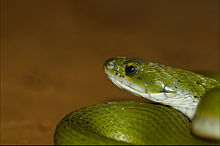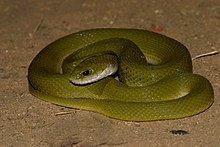|
Rhabdophis plumbicolor
Rhabdophis plumbicolor, known as the green keelback or lead keelback, is a species of nonvenomous snake in the family Colubridae native to parts of the Indian subcontinent.[1] Description
   R. plumbicolor is stout and viper-like in body structure, and about 2 ft (61 cm) in total length (including tail) when fully grown. The eye is moderately large. The rostral scale is just visible from above. The suture between the internasals is as long as that between the prefrontals or a little shorter. The frontal scale is as long as its distance from the end of the snout or a little longer, as long as the parietals or a little shorter. The loreal scale is as long as deep or deeper, sometimes touching the eye. There are two preoculars scales and three or four postoculars. The temporals are 2 + 3 or 4. There are 7 scales on the upper lip (supralabials), the third and fourth touch the eye; and 4 or 5 lower labials in contact with the anterior chin-shields, which are shorter than the posterior. The dorsal scales are strongly keeled, in 23 to 27 rows at midbody. The ventrals scutes are 144-160 in number, and the anal is usually divided. The subcaudals scales are 35-50 in number. R. plumbicolor is dull green above, uniform or with traces of black markings.[2] Young specimens show an inverted black V-mark on the neck, its apex forwards, reaching to the frontal shield, and a second much smaller one behind, the intervening space being bright yellow or orange; a black stripe from the eye to the angle of the month, and more or less regular transverse spots or cross-bars on the back and tail; belly whitish, yellow or plumbeous, rarely with darkish spots.[3] BehaviorIn disposition R. plumbicolor is very gentle, and in threat may flatten the neck and raise the head like a cobra while other specimens may flatten the entire body on the ground. DietR. plumbicolor feeds mainly on toads.[3] Geographic range and habitatR. plumbicolor is found in peninsular India and Sri Lanka especially on the hills rather than on the plains. A large specimen was found at an altitude of 4,700 ft (1,400 m), in the Anaimalai Hills by Mr. W. Davison.[2] It is also found in Pune, Maharashtra, Bangladesh, Myanmar, and possibly Pakistan.[4] ReproductionR. plumbicolor is oviparous.[4] SubspeciesTwo subspecies are recognized as being valid, including the nominotypical subspecies.[4]
References
Further reading
|
||||||||||||||||||||||||||||||||||||||


